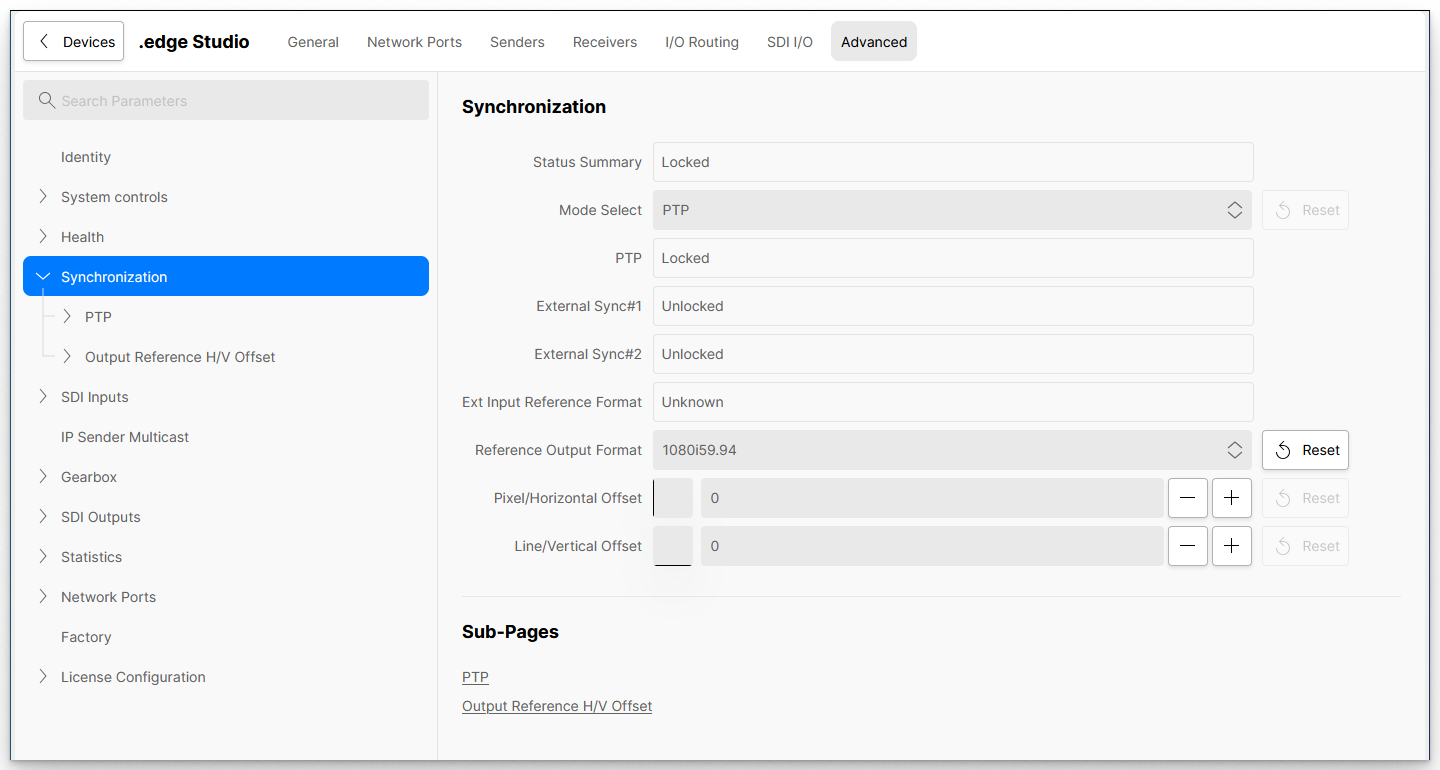.edge - Synchronization
Each processing blade can sync to an external reference signal, PTP arriving from the media network or its own internal sync generator.
Usually, PTP (Precision Time Protocol) is the preferred option. If PTP is not available, then you can connect up to two external reference signals (to the IN connectors on the rear I/O plate) and daisy-chain these to other devices (using the THRU connectors). If there is no PTP or external reference, then the processing blade can sync to its internal sync generator. In this mode, all streams are free-running.
In each case, the sync reference must be set manually (as described below).
Configuration via HOME
The sync reference for a processing blade is defined using the Synchronization options (in HOME's Advanced parameters).
From the main "Devices" list, click on the processing blade label (to open the "Device Details" as described earlier). Then select the Advanced tab and Synchronization.

Synchronization (main page)
From the main page, the Mode Select field sets the system reference. The Status Summary shows Locked when a valid reference is selected.
If Mode Select is set to PTP, then the PTP sub-pages become relevant.
Changing the Sync Reference
Click on the Mode Select field to set the system reference. There are four possible options:
- External Ref#1 – connected to REF 1 IN on the rear I/O plate.
- External Ref#2 – connected to REF 2 IN on the rear I/O plate.
- PTP – arriving from the media network.
- Free Run – the internal sync generator.
The PTP, External Sync#1 and External Sync#2 fields show the Locked/Unlocked status of each option.
If the system reference is set to one of the external inputs, then the Ext Input Reference Format field shows the format of the incoming signal.
Setting the Sync Output Format
The Reference Output Format field defines the video format used for the sync output (connected to REF OUT on the rear I/O plate).
The two offset fields can be used to add an offset to the selected video format:
- Pixel/Horizontal Offset - adds a horizontal offset (in pixels) to the Reference Output signal (REF OUT on the rear I/O plate). The offset is applied to the output format selected in the Reference Output Format field.
- Line/Vertical Offset - adds a vertical offset (in lines) to the Reference Output signal (REF OUT on the rear I/O plate). The offset is applied to the output format selected in the Reference Output Format field.
Using PTP
For correct synchronization via PTP, the media network requires a PTP master clock source. This can be achieved by using a streaming node or installing a separate grandmaster device. A PTP master should be capable of taking an incoming sync signal and generating PTP clock. You can read more about the PTP implementation in the Lawo IP Networking Guide. For now, it is useful to know that:
- .edge can operate as a PTP slave only. This means that the processing blade looks for an incoming PTP signal from the media network (e.g. from an external grandmaster).
- At any moment in time, there can be only one PTP master operating on the network.
- If a device is set to master-slave mode, then the current mode is determined by the PTP priorities set within the device itself and all other streaming nodes.
The PTP parameters for the processing blade are adjusted from the Synchronization → PTP sub-pages (in HOME's Advanced parameters).
If a valid PTP clock signal is detected, then the PTP field will show Locked.
Using an External Reference
If PTP is not available or you wish to connect a backup sync pulse generator, then you can connect up to two external reference signals.
The reference signal(s) must conform to SMPTE ST125.
To make the connections, use the 2 x REF IN connectors on the rear I/O plate. In each case, the REF THRU connector provides a "looped-through" output of the corresponding IN. This allows you to daisy-chain the incoming signal to other blades/devices.
If a valid reference signal is detected, then the External Sync#1 or #2 field will show Locked.
Please note:
- For correct synchronization without PTP, the same reference signal must be distributed to all streaming nodes. If multiple sync sources are used, then they must be referenced to a single common basis (e.g. GPS).
- All nodes must support syntonized streaming. This is true for all Lawo media network interfaces, but must be checked for third-party devices.
Using the Sync Output
The REF OUT connector on the rear I/O plate provides an output of the processing blade's reference: PTP, IN 1, IN 2 or Internal (free-running).
By setting the reference to PTP, the processing blade can receive PTP from the media network and provide tri-level sync to other non-PTP devices.
You can use the Reference Output Format field (described above) to define the video format used for the reference output.